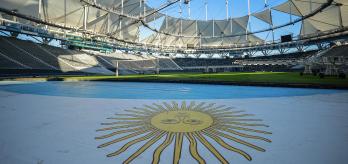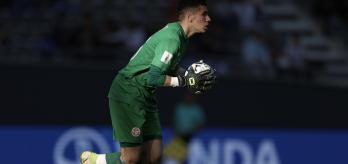Italy boasted a number of players who were highly comfortable in possession. This made them extremely difficult to defend against, as they could progress the ball up the pitch with both feet at high speed. The way Italy played their 4-4-2 diamond system against Brazil’s 4-4-2 with a flat midfield made it easier for them to generate overloads in central positions, meaning they could always get a midfielder free to receive the ball.
As (16) Faticanti and (4) Prati were able to rotate the role at the base the of the diamond, one of the pair was consistently able to get free to help the team progress the ball from their build-up. The movement to receive from their two centre-forwards was also instrumental in Italy's ability to receive the ball between Brazil’s midfield and defensive lines, as were the relentless work ethic and movement of (8) Casedei and (10) Baldanzi.
As we can see in the clips below, it was this exact pattern of play that lead to their opening goal of the game. As (16) Faticanti received the ball from his goalkeeper and turned, (20) Pafundi dropped in from the centre-forward position to receive a pass. He then had five players occupying the space between Brazil’s lines, and once he played vertically through those lines, the speed at which Italy moved the ball was crucial.
No player took more than two touches as they progressed the ball wide to left-back (3) Turicchia, who shifted the ball comfortably onto his right foot before lofting in an inch-perfect cross that was flicked on by (18) Esposito. The move was finished with one touch by midfielder (4) Prati, whose performance also made him the player who covered the longest distance in the opening round of fixtures.
As Julio González observed, "We can see how Italy like to start play with the goalkeeper and (1) Desplanches was excellent at reading where the space was to find players between the lines. The speed at which they moved the ball up the pitch made it very difficult for Brazil to defend, especially with so many support runners, who were hard to track. It's also important to watch how their players receive the ball, with open body shape and with intent to play forward. This really increases the speed of their play.”
According to Pascal Zuberbühler, Italy’s approach was very impressive. "I enjoyed watching how they played vertical, their speed, power and tempo. The movement and understanding between all players, including the goalkeeper, showed great maturity in their play. The intricate passing movements and how the players manoeuvred between the lines was very impressive."
Versatility in their approach
Italy demonstrated versatility in how they progressed the ball, but although their build-up patterns were varied, the principles of their play were consistent.
We see this in Clip 2, where they build from the back in a shape that features two narrow centre-backs and two low full-backs, along with the diamond midfield structure and one centre-forward dropping in a little deeper.
Safe in the knowledge that both centre-backs are very comfortable stepping in with the ball, left-back (3) Turicchia pushes high into the space ahead of him. Meanwhile, (8) Casedei, who has been playing on the left of the diamond, pulls out wide and gets an offer to receive from (10) Baldanzi, playing at the top of the diamond. Throughout the game, as soon as the ball entered the final third, Italy wanted to play with minimal touches.
For González, these movements by Italy came from the training ground and had clearly been worked on, as was evident in the level of understanding between the players.
"The players trusted each other. They knew where each player would be and that meant they could play with so few touches knowing the next player would be where they were supposed to be. They had different ways to play but, always, the players knew what was expected of them and worked hard to be in those positions. This style of play from Italy was very nice to watch," he added.
Willing runners with the ball
Other standout elements of Italy’s ability to progress the ball at speed included the number of players willing to run with the ball and the supporting runs from the players around them.
In Clip 3, we see Italy’s defensive aggression facilitating a possession regain before (10) Baldanzi makes a scintillating run with the ball to progress the counter-attack. The explosive supporting runs by four of his teammates ensure he never gets isolated and has options available to continue the attacking phase. His supporting midfielder (8) Casadei was eventually fouled in the penalty area after a take-on. He went on to covert the resulting penalty himself to give Italy a 3-0 advantage.
For Zuberbühler, (10) Baldanzi’s low centre of gravity, speed and close control when running with the ball was a key factor in Italy’s ability to break lines. He was also ranked number one in the game for receptions between the opposition’s midfield and defensive lines, with 22.
"Baldanzi’s movement to receive and ability to receive between the lines was exceptional. He and (20) Pafundi were also fantastic at carrying the ball throughout the game, and the way (8) Casedei moved between the lines to support the play was so enjoyable to watch. For the penalty, Italy had five players in the area at the time of the challenge, they were always so willing to sprint hard to make sure they got to the dangerous areas."
Using rest defence to support attacks
Italy displayed great courage in attack, showing a desire not only to attack at speed, but also to take risks by progressing the ball with the minimum number of touches. This bravery was also reflected in their defending, where they were comfortable in their rest defence structure and content for their defenders to be 1v1 with the opposition forwards.
As we see in the clip below, as the attacking phase progresses, they are prepared to be man-for-man, with seven outfield players in the attacking third and three 1v1's across their rest defence.
As González points out, Italy’s intent to play forward at the earliest opportunity is very evident in this passage of play.
"They know what they want to do and commit players to support their attacking play, but also, they are prepared to believe their defenders can operate with the same number of players as Brazil if they transition to attack. This is a very admirable approach and shows their commitment to their style of play, regardless of the score line."
Data insights
When we look at the data, we can see that Italy had the narrowest team width (36m) when in the final third of any team who has played so far in the tournament. This emphasises how they tried to break Brazil down vertically. They also had the narrowest average team width in both the low build-up and mid build-up phases of play.
Although Italy played very narrow in attack, they still covered more ground than most other teams, ranking third-highest in total distance covered across the opening round of group stage matches. This distance was also covered at pace and intensity, as they ranked highest in distance covered in high-speed running.
In short, Italy’s strategy in this match can be summed up as one of high risk, high speed, and high reward.





















